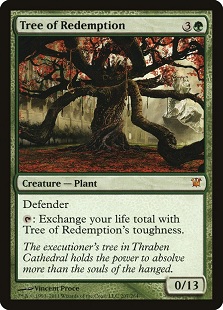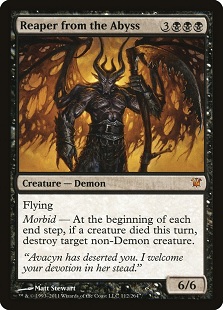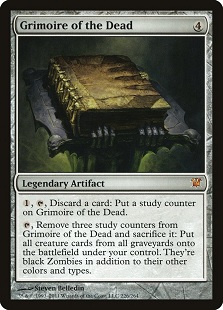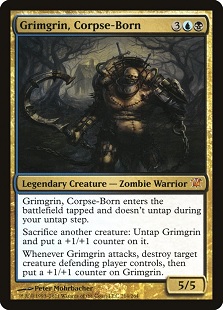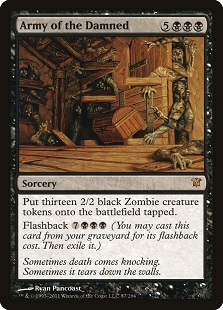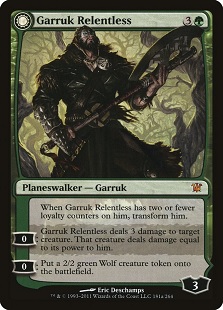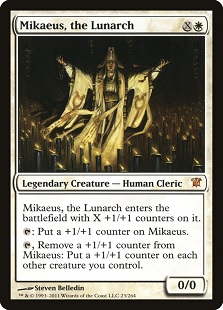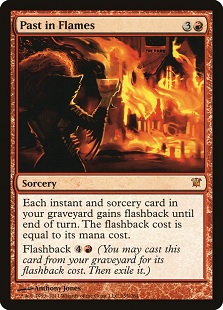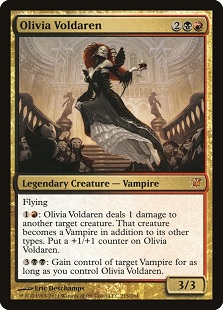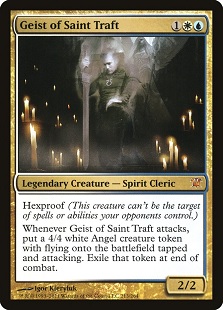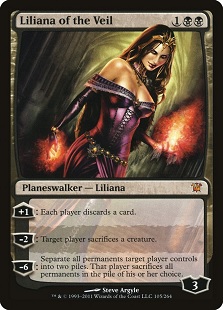Innistrad was the first set where I really remember sitting down with it and immediately going, "This feels weird to say, but I think this might be the best set of all time?" That was genuinely how I felt after just one prerelease, it was that good. All of the games felt like they played well against one another, almost nothing felt too egregious over others with some exceptions (looking at you Invisible Stalker), and it had some clear all-time favorite designs. It was a banner set for Magic right away and since has rightfully become widely considered as one of the greatest sets Wizards has ever produced for the game.
So, when you have one of the best sets of all time, how do the mythics stack up? Are they all winners or are there some real duds still along the way? They can't all be winners after all, but make no mistake: Innistrad is a set packed with awesome goodies, and especially at the mythic slot, so we're going to rank all of them! Let's dive right on in now!
Number Sixteen
This card always just felt fine. It's safe, and in a dull way. It's almost as though it were designed like it was aimed at being good and then just ultimately missed the mark, because everything about it feels like it should be for Standard play. It's not good enough for older formats, does little to nothing in Commander, and is fine for Cube, I suppose. I'd argue it's actually better than a lot of the other lower end on this list, but at least they have something about them that makes them feel unique. This just ends up feeling bland and uninteresting in addition to being unplayable, which as far as I'm concerned is as much of a losing combo as it gets.
Number Fifteen
Now conversely, let's check out Mirror-Mad Phantasm. It's obviously way weaker than Angelic Overseer, which can be a pretty hard hitting beater with the right setup. Mirror-Mad Phantasm almost begs to be used as an odd self-mill combo sort of card, but it's difficult to make it work with any kind of real efficiency. For as unplayable as it is, it still makes the player want to find a way to do something with it, which makes it a truly interesting card, even if it's ultimately not very good.
Number Fourteen
Essence of the Wild reads like an awesome card. Everything you play comes in as a copy of it, meaning that you're going to continuously create a deluge of beefy beatsticks that are tough for your opponents to deal with. The card ultimately has two problems, though. The first is that it kills a lot of your value plays that you might hope to take advantage of. For example, let's say you want to play an Avenger of Zendikar for the value of getting an army of 6/6s. Well, the Avenger entered as an Essence of the Wild, so you never get the plant-making ability. The second bit is that it's hard to turn off once it gets going because even if the original dies, the copies still make more copies. It's a cool design that ultimately feels rather dull and unexciting once you actually get the chance to play with it.
Number Thirteen
If you were around for Masters 25 you might remember just how lambasted the choice to include this as one of the mythics of the set was. When the original Innistrad set was released, though, it was hailed as a really cool and unique card. Like many of the other lower end cards on this list, it never saw a tremendous amount of play, but it does enable you to make some really fun plays. On top of that, it was a really cool design with great art, making it memorable even if it wasn't very impactful.
Oh, and in case you were wondering, it's actually the 9th most expensive mythic from Masters 25 out of 15 mythics in that set. It's still not worth too much - only around $4-5 - but it's funny to think about given the blowback that choice received at the time
Number Twelve
Few cards have been overhyped to the degree of Skaab Ruinator. On paper, the card reads incredibly, allowing you to get a massive creature out on turn three. To many, it felt like we were witnessing the second coming of Tarmogoyf and everybody wanted to get their hands on it. As it turned out, needing to exile three creatures from your graveyard was a much taller order than players anticipated. While Skaab Ruinator did see some amount of play, it was far less than the card players expected it to be, but for one fleeting moment, everybody wanted to make it happen.
Number Eleven
Reaper from the Abyss is an awesome case study in bulk mythics that are way better than their value might make them appear. I remember back then when a good friend of mine kept opening them and grumbled because of how worthless they were and how "this could've been a Liliana!" In practice, though, the card was an absolute house in Limited, massacring board states while simultaneously obliterating opponents' life totals. It's also no slouch in Commander where it's continuously going to get the chance to blow up creature after creature. It's not universally appealing or anything, and it is still bulk, but when it's good, you might be surprised that it's really good.
Number Ten
This feels like the little card that could. A clear nod to the Necronomicon of HP Lovecraft and Evil Dead fame, this card is a slow burn attempt at mass reanimation. It takes a lot of setup to get going - including plenty of time - which often discourages players from running it due to that requirement and how easily it can be interrupted. However, the allure of being able to go off with it and get your very own Rise from the Dark Realms in one super flavorful swing is awesome. It's a casual player's kind of card, but it's a perfect one for that crowd.
Number Nine
I'll be that person and say I find this card to be a really boring design and - to be frank - the concept of dragons on Innistrad, particularly this one, has always felt a little odd to me. Still, casual players love it, and it's got high Commander appeal. All it takes is for you to connect once with it and you'll be wiping out most of their board in the process as well. It dominates things once it's on the board, but you have to get it there in the first place with that high mana cost, get it to hang around a turn (or give it haste), and find a way to make it hit through fliers for decent value. That's a whole lot of hoops for my liking, but hey, people love it so I give it credit where credit's due.
Number Eight
Here we have the true archetypal Zombie kindred legend. Grimgrin was a fan favorite for years that slowly crept way up in price due as Commander continued to grow more and more popular with time. It's a great way to get a slow sacrifice engine going, swing in for massive damage, all the while repeatedly blowing up opposing creatures that get in your way. Just a big dumb zombie that's a ton of fun to have in the command zone, and who could say no to that?
Number Seven
It's such a simple, elegant design that's simultaneously tremendously evocative. Everyone I know wanted to find a way to cast this beastly spell, even if it basically meant you just got a bunch of vanilla tokens. The flavor is absolutely on point and it's dripping with casual appeal that makes it a beloved Commander card even to this day.
Number Six
Now here's an interesting one. Garruk Relentless was a great card primarily in two formats: Standard and - believe it or not - Legacy! A number of decks in Legacy soon after the release of Innistrad were utilizing this iteration of Garruk in some form or fashion. I remember playing it in Maverick myself, even, for the utility of making tokens and removing problematic creatures. What's interesting is that in spite of its Constructed prowess, Garruk Relentless never really saw very much Modern play, nor is it a particularly good Commander card. It's very much a card of its era that was unique in where it showed up, and while it's fallen way off today, is still fondly remembered for how cool it was at the time - especially for being novel as the first double-faced planeswalker card.
Number Five
I failed to mention this with both Shards of Alara and Scars of Mirrodin - both of which had similar occurrences - but Mikaeus was actually inserted into From the Vault: Legends as an early preview for Innistrad. There was a little bit of buzz about him, mostly because you could basically make him as big as you wanted. From there, you could pump up your entire board, which seemed great for go-wide strategies. The card saw minor Constructed play but ended up being much bigger in the casual sphere, being easily one of the most played Commander cards in the set and for good reason.
Number Four
In a set with so many standout cards I was honestly a bit surprised to see this one has the highest EDHREC rank as being the most utilized in Commander. Not only that, but the card sees tons of play in multiple non-rotating formats and Cube. The uses in those spaces are very specific, though, which is why I'm surprised it's played to quite the degree it is. Where it's good, however, it's incredibly good. Also, I totally buried the lead on this one and failed to mention the whole players comparing this to Yawgmoth's Will - a famously busted in half card - when this was previewed. A very niche, but massively impactful card where it counted.
Number Three
These days I think most people know of Olivia for her utility in Commander, being a great way to both take out creatures and also to take control of them from your opponents. What players might not remember is how awesome she was to play with in Constructed formats once upon a time as well. If you were playing Standard or Modern, there were decent odds you'd run into a Jund Midrange list playing Olivia in it as a top end finisher that could also clear the way for your other powerhouse creatures. She's far outclassed today, but for years, she was one of the best things you could be doing in many areas, and her reputation today at the very least stems from that.
Number Two
Few cards are victims of time and power creep quite like Geist of Saint Traft. The card sees almost no play anywhere and can be had for barely a dollar - less, even. If you were playing in the early to mid 2010s, though, Geist was an unstoppable juggernaut that dominated games of Standard, Modern, and even Legacy to some extent. Within a few years' time the card was outclassed but in its heyday it was one of the best things you could be doing hands down. All you needed was to stick a copy of Geist and then defend it with countermagic and removal and you'd close out the game in no time flat.
Number One
At first blush, many players didn't know what to expect of Liliana of the Veil. She was cheap and had some removal on her, but was it really that good to make yourself discard as well as your opponent to make use of the +1? Turns out that it sure was! Liliana started around $30-40 thanks to the "Jace Tax" at the time that caused all planeswalkers to be inflated price-wise early on. Usually, they decreased as they turned out to not be that great, but in this case it kept going up and up, reaching prices around $70-80! Liliana became an instant mainstay in Standard, Modern, Legacy, and Cube - and even now shows up in the current iteration of Standard and in Pioneer! Throughout the 2010s she was in strong contention as one of the best planeswalkers of all time and it wasn't particularly close outside of Jace himself. Easily one of the greatest of all time.
Paige Smith
Twitter: @TheMaverickGal
Twitch: twitch.tv/themaverickgirl
YouTube: TheMaverickGal



















